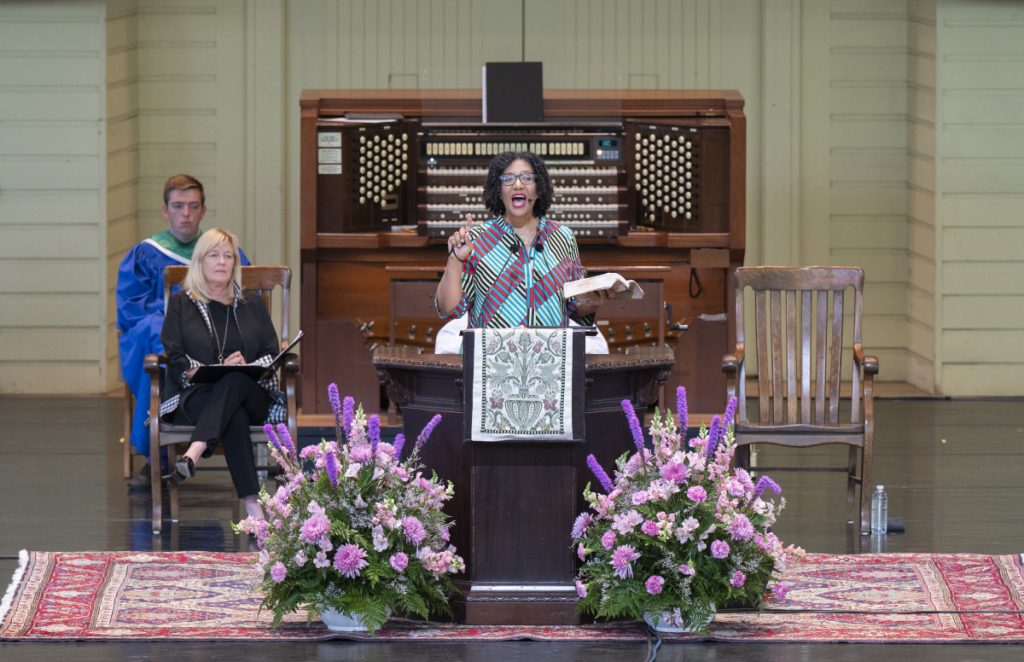MARY LEE TALBOT – STAFF WRITER

“Four years ago, with a group of clergy, I stood off men with AR-14s for an hour before mayhem broke out. We were in Charlottesville and confronted white nationalists,” said Lisa Sharon Harper. “This was a precursor to Jan. 6, 2021.”
Harper preached at the 9 a.m. Friday worship service in the Amphitheater. Her sermon title was “The Call to Beloved Community,” and the Scripture reading was Psalm 85:10-13.
Harper continued, “Clarity came into the world for me on the role of race in the world.” The death of Trayvon Martin in 2012 had been wearing on her. In 2013, his murderer was found not guilty. For Harper, that clarified the central struggle about race and led her to try to understand what might be needed to end the struggle.
She began her exploration with the philosopher Plato in 360 B.C.E. Plato defined race as the different metals found in human bodies. Some bodies had gold, some silver, some copper. “These metals determined how each person served society. I am not sure if there was a hierarchy, but race was meant to order society, and it became hierarchy,” Harper said.
Aristotle, a student of Plato, made hierarchy explicit, she said. “There was an explicit hierarchy, not based on skin color, but on other characteristics. Barbarians were created to be enslaved, those who were less intelligent were enslaved, and those who allowed themselves to be conquered were enslaved. The top of the hierarchy was white, male and able-bodied.”
Fast forward, she said, to the papal bull of 1454 issued by Pope Nicholas V that paved the way for the Doctrine of Discovery. The pope gave explorers the power to claim land and enslave the people they found there. The category of race moved from philosophy to religion and deemed some people civilized and some savages.
Another fast forward to Carl Linnaeus, who developed the taxonomy or classification for plants and animals. “He decided to classify humans, and at the top was white Europeanus, then red Americanus, yellow Asiaticus and Black Africanus,” Harper said. “Then fast-forward to the United States Constitution, which said Black people were counted as three-fifths of a human for census purposes. In the first census, only whites were mentioned.”
She continued, “Everything revolved around whiteness. In the Immigration Act of 1790, those who wanted to be naturalized citizens had to be white men of good character. Who could be enslaved? Anyone with an African for a mother.”
The 14th Amendment to the Constitution was a turning point, she said, because “for the first time the law declared that all people could be citizens and exercise dominion. Then the 15th Amendment said only men could be citizens.”
Harper told the congregation, “We are in a struggle for the soul of America, the way we govern this land and the way we move through the world. We are in a struggle for the soul of America, and I wonder, can we give all citizens the right to flourish? The day America decides to repair relationships, to open its arms to all to exercise dominion, then we will become a partner with God.”
She continued, “Right now is the time of reckoning. Within 24 years, people of color will be the majority in the population. Robert Jones, author of White Too Long: The Legacy of White Supremacy in American Christianity, did a survey through the Public Religion Research Institute, in which he asked people, ‘Do you long for the 1950s?’ The majority of white people, across the board, said yes. The vast majority of people of color said, ‘Hell no.’ ”
Harper reminded the congregation that the 1950s included redlining real estate so Black GIs could not buy homes — before the Voting Rights Act and the Civil Rights Act, before the Stonewall uprising and before the Americans with Disabilities Act.
“When was the last time, the last era when white men entered a room or a place, they did not imagine that they should rule there?” Harper asked the congregation. “It was in Greece, almost 3,000 years ago. Europeans have no common memory of not ruling. We are in a new era and people of color make up the majority of the population of the world and in this nation they will be leading the country. We have two options: We can wage a war for supremacy, or we can embrace the beloved community.”
Martin Luther King Jr. described the beloved community as a global vision, that all people would share in the wealth of the world. There would be international standards that would not allow hunger, poverty or homelessness. Racism would be replaced with sisterhood and brotherhood.
She said her book, Fortune: How to Repair the World that Racism Broke, will be coming out in February 2022 and in its last chapter there is a call to truth, a call to repair the world, a call to beloved community. “This is our call. This is our call,” Harper said. “Will you join the movement toward the beloved community?”
At the beginning of her sermon, Harper thanked the Seneca and Erie Nations, the Iroquois Confederacy for being stewards of the land and blessed their elders, past, present and emerging. The Rev. Paul Womack presided. Alison Marthinsen, who is involved in a ministry with the homeless in Toronto, read the Scripture. For the prelude, Joshua Stafford, who holds the Jared Jacobsen Chair for the Organist and is director of sacred music, played Prelude and Fugue in C Major, by Johann Sebastian Bach. Members of the Motet Choir sang “Mercy and Truth are Met,” with music by Ned Rorem and words from Psalm 85:10-13. The postlude was Toccata from Symphony No. 5, by Charles-Marie Widor. The Alison and Craig Marthinsen Endowment for the Department of Religion provided support for this week’s services and chaplain.




